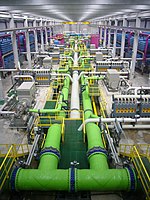
Photo from wikipedia
Abstract The southeastern US has experienced an increase in the number of extreme heat events since the 1970s, due in part to global change. Despite rising temperatures, greater variability in… Click to show full abstract
Abstract The southeastern US has experienced an increase in the number of extreme heat events since the 1970s, due in part to global change. Despite rising temperatures, greater variability in weather has also led to more freeze events across parts of the Southeast, particularly during El Nino winters. Structural variation in forest stands and plant functional diversity can lead to localized micrometeorological differences that may alter the recovery of different forests from these temperature-induced disturbances. This variation can lead to differences in energy and entropy dynamics, which drive the metabolic response of these systems. Using thermodynamic metrics, we quantified metabolic energy and entropy production in response to extreme heat and freeze events at three longleaf pine savanna sites spanning an edaphic moisture gradient (i.e., xeric, intermediate, mesic). The sites also differed in anthropogenic legacy, with soil tillage occurring at the intermediate site, resulting in greater woody species abundance in the understory and overstory. We found that energy reserves in this ecosystem were built during low precipitation periods and when temperatures were below 20°C. The mesic site, which had the highest plant functional diversity, exhibited an adaptive capacity to temperature extremes by maintaining low metabolic activity throughout temperature disturbances, while the intermediate and xeric sites started with high metabolic activity that gradually declined by ~15% with prolonged temperature extremes. Response to these temperature extremes was a function of hydrological drivers, as lower water availability reduced energy reserves during cold periods and photosynthetic activity during heatwaves – especially at the intermediate and xeric sites as a result of the high energy demand of oaks in the overstory. As climate change continues to alter weather patterns across the globe, it becomes increasingly important to assess metabolic resilience to greater weather variability as a function of ecosystem structure.
Journal Title: Agricultural and Forest Meteorology
Year Published: 2020
Link to full text (if available)
Share on Social Media: Sign Up to like & get
recommendations!